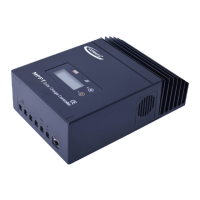Operaon4.0
The MPPT operation is fully automatic. After installation is completed, there are few
operator tasks to perform. However, the operator should be familiar with the operation and care
of the MPPT as described in this section.
4.1 MPPT Technology
MPPT stands for "Maximum Power Point Tracking". This describes a process by means of
which the solar module is always operated at the point of maximum possible power. Because
the point the maximum power can vary depending on the operating mode and the local
conditions, and because it changes in the course of the day, the term "tracking" is used,
i.e. the tracking of this point.
Current Boost
Under most conditions, MPPT technology will “boost” the solar charge current. For
example, a system may have 36 Amps of solar current flowing into the MPPT and
44 Amps of charge current flowing out to the battery.The MPPT does not create
current! Rest assured that the power into the MPPT is the same as the power out
of the MPPT. Since power is the product of voltage and current (Volts x Amps), the
following is true*:
(1) Power Into the MPPT = Power Out of the MPPT
(2) Volts In x Amps In = Volts Out x Amps Out
* assuming 100% efficiency. Losses in wiring and conversion exist.
If the solar module’s maximum power voltage (V
mp
) is greater than the battery voltage, it follows
that the battery current must be proportionally greater than the solar input current so that input
and output power are balanced. The greater the difference between the V
mp
and battery voltage,
the greater the current boost. Current boost can be substantial in systems where the solar array
is of a higher nominal voltage than the battery.
An Advantage Over Traditional Controllers
Traditional controllers connect the solar module directly to the battery when recharging. This re-
quires that the solar module operate in a voltage range that is usually below the module’s V
mp
. In
a 12 Volt system for example, the battery voltage may range from 10 - 15 Vdc, but the module’s
V
mp
is typically around 16 or 17 Volts.
Figure 4-1 shows typical current vs. voltage and power output curves for a nominal 12 Volt
off-grid module.
13

